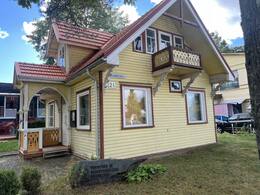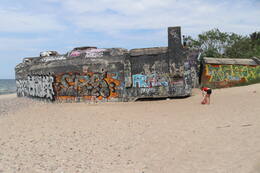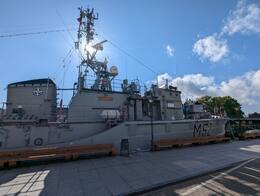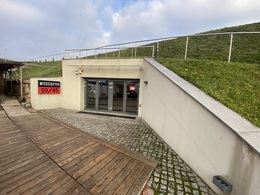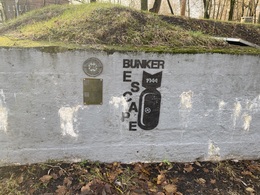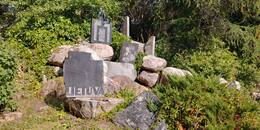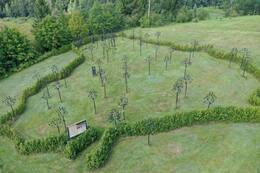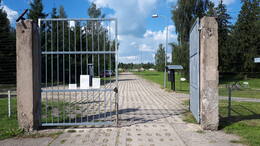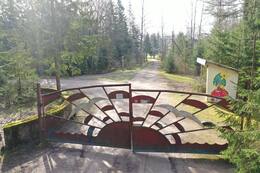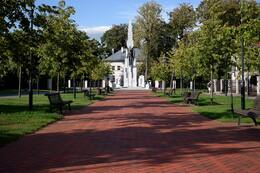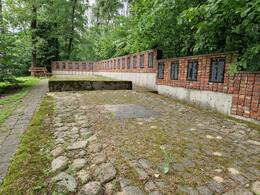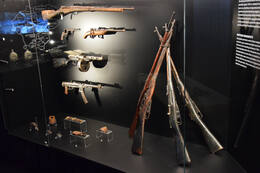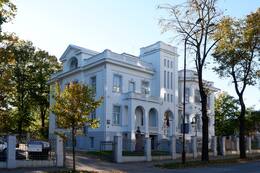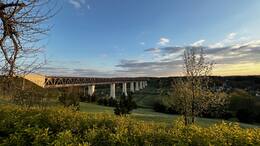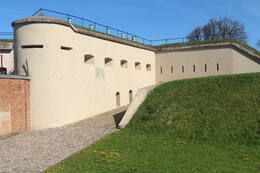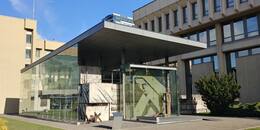Military heritage along the Iron Curtain
Museum of Exile and Resistance in Palanga
The museum is located in downtown Palanga, in one of the smallest wooden villas of the Palanga resort – Vaidilutė. It was established in 1993, based on the initiative of the Palanga branch of the Lithuanian Union of Political Prisoners and Deportees. The department continues to look after the museum today on a community basis. The volunteers have adapted the villa to the specific needs of the museum and lead the tours themselves.
The exhibition tells the story of the participation of Lithuanians in the resistance movement and the deportations that destroyed people’s lives.
“Memel-Nord” Coastal Artillery Battery
The coastal artillery battery "Memel-Nord" is located in Giruliai, near the Dutch Cap on the Baltic Sea coast.
The coastal artillery battery "Memel-Nord" is an integral part of the German Navy's coastal defense system, which was built in 1939 after the Klaipėda region was annexed to Germany and fortification work began in the city. "Memel-Nord" is an integral part of the Klaipėda city fortifications, consisting of two coastal artillery and six anti-aircraft defense batteries.
The coastal artillery battery was built in two stages, in April and May 1939 a temporary coastal artillery battery was built, and at the end of 1939 a decision was made to expand it and turn it into a permanent position. For this purpose, four artillery gun positions were built in the coastal artillery battery, which were equipped with 150 mm SKL-45 artillery guns, fire control posts and an ammunition depot designed to store 150 units of artillery shells. After these constructions, the battery was given the name Brommy.
The battery consists of three buildings, in the center there is a concrete fire control post, next to it there are two artillery blocks with ammunition storages. Since 2002, an exhibition telling the history of the Klaipėda region has been operating in one of the artillery blocks.
Mine countermeasures ship-museum M52 "Sūduvis"
The M52 “Sūduvis” mine countermeasures ship-museum is located on the Karališkoji Danės waterfront of Klaipėda, next to Castle Bridge.
It is a “Lindau” mine trawler class ship, built in 1956–1958 in West Germany. The mission of these ships is to detect and destroy sea mines. The hull was therefore made of Brazilian oak, the deck of teak, and the machinery, of non-magnetic metal.
From 1958 to 1999, the ship belonged to the German Navy and was named M1071 “Koblenz”. From 1978–1979, it was converted from a mine trawler to a mine hunter.
In 1999, the ship was transferred to the Lithuanian Navy. Navy ships are traditionally named after historical regions of Lithuania, so the received ship was also named M52 “Sūduvis”. The ship served Lithuania for 22 years, taking part in international and national exercises and operations. In 2021, the ship left the service of the Lithuanian Navy and was handed over to the Lithuanian Maritime Museum. Then, 52 “Sūduvis” was opened to the public and adapted for the needs of museum and educational use. The vessel on display has authentic operational equipment.
World War II Exposition “Muziejus 39/45”
“Muziejus 39/45”, which belongs to the History Museum of Lithuania Minor, tells the story of the Second World War events in Klaipėda and the region. The museum is located under a rampart on the eastern side of the former Klaipėda Castle, where German troops had set up an explosives depot during the war.
The exposition of the museum is modern and engaging for visitors: the exposition consists of four halls that present different periods of the wartime, and 13 interactive points have been installed in the halls. The hall “Klaipėda on the Eve of War” displays historical documents and photos, while the radical changes in Europe of the time are described on an original animated map. The hall “The Storming of Klaipėda” reflects the very tragic history of Klaipėda and its inhabitants, while the second hall “Klaipėda after the War” features an installation commemorating the demolished churches of the city. The last one – the Hall of Memories – features a symbolic six-metre-long carriage with a glass roof, under which multiple simple household objects that once belonged to both German soldiers and Klaipėda civilians are on display. The glass is coated with a layer of sand, so you have to brush the sand off with your fingers to see the exhibits.
“Escape bunker 1944”
“Escape bunker 1944” is located in the city centre of Klaipėda.
It is a German Army tunnel shelter built in 1944 to help the civilian population of Klaipėda survive the bombing and artillery shelling of World War II. This shelter is believed tohave been built by the Railway Administration of the Reich. The bunker is made of one-metre-thick reinforced concrete walls with an earth embankment on top.
Since 2009, the shelter has been included in the Register of Immovable Cultural Property of the Republic of Lithuania, and the site has been marked with a military heritage label. Long neglected, it was restored in 2016 pursuant to a private initiative. It is now an escape room, a room for solving puzzles, which, consequently, prevents the shelter from deteriorating while creating entertainment for the residents.
Orvidai Homestead-Museum
The Orvidai Homestead-Museum is located near Salantai, on the right side of the road Salantai-Plungė (KK169) (there are information signs).
The site was started more than 40 years ago by a family ofstone cutters – a father and son – Kazimieras and Vilius Orvidai (1905–1989; 1952–1992). During the land improvement works, they brought interesting-looking stones scheduled for crushing and centuries-old trees from the surrounding fields to their homestead and used them to create religious monuments. The works created by the Orvidai themselves at their farm homestead, as well as works by other artists displayed there did not conform to Soviet ideological and artistic canons: the works made of stone, wood, metal and old agricultural tools intertwined the symbolism of different religions (Catholic, Pagan, Buddhist). The homestead was also well known to those who did not fit into the reality of Soviet life. The place became a site of refuge and gathering for those who thought differently. The Soviet power repeatedly planned to destroy this environment, however, people managed to preserve it. The Orvidai homestead became very popular during the Lithuanian revival.
An IS-2 tank welcomes visitors at the Orvidai Homestead-Museum. This tank was developed by the Soviet Union during World War II as a response to the German Tiger I. The name IS is an acronym for the Soviet tyrant Joseph Stalin. This tank was formerly located in Salantai as part of the Memorial dedicated to the World War II Soviet burial. In 1991, it was relocated to the Orvidai homestead and became an exhibit.
Litvak Memorial Garden
In 2014, the Jacob Bunka Charity and Support Foundation established the Litvak (Lithuanian Jew) Memorial Garden in Žemaitija National Park, approximately two kilometres from the centre of Plateliai, in the village of Medsėdžiai. It is a monument dedicated to the eliminated Jewish communities of Lithuania. The garden reproduces the contours of Lithuania, while the sites where Jewish communities were eliminated in 1941–1944 are marked with wrought-iron apple trees. The author of the carved apple trees is Artūras Platakis. The apples in the trees signify families that have lived in these communities. Litvaks from around the globe can participate in the development of the garden by ordering new apple trees and apples in memory of their ancestors. The garden also features pillars made of Karelian granite that individually celebrate the achievements of Litvaks worldwide.
In 2016, the initiative was extended to include the Litvaks, who lived throughout the territory of the Grand Duchy of Lithuania, and the rescuers of Jews during the Holocaust. A billboard at the entrance to the garden tells the story of former Jewish communities throughout Lithuania.
Currently, apple trees to commemorate the Jewish communities of Alytus, Alsėdžiai, Kalvarija, Mosėdis, Plateliai, Plungė, Telšiai, Vabalninkas, Viekšniai, and others have “grown” at the garden.
Cold War exposition
On 31 December 1962, one of the first underground launch complexes for R-12 ballistic missiles in the Soviet Union, the Dvina underground launch complex, was put into operation
in Plokštinė Forest (Plungė district).
Between 1963 and 1978, four R12 medium-range ballistic missiles (SS-4 Sandal) equipped with a 2.3-megatonne nuclear warhead were deployed at the complex. All the missiles were aimed at Western European countries. This complex, together with similar surface-launched missile bases, formed a single Soviet nuclear arsenal in Lithuania, which was capable of destroying the whole of Europe. In its 16 years of operation, not a single missile was fired, despite the declaration of combat readiness during the Prague Spring in 1968.
After the Soviet soldiers left on 18 June 1978, the poorly guarded military facility was vandalised and looted. In 1993, when the complex was handed over to the Žemaitija National Park Directorate, its restoration began. In 2012, the Cold War exposition was opened. Today, this once very secret and guarded place is open to the public. A historical exposition on the Cold War period is on display at the former missile and equipment control room house. To date, it is the only museum in urope where a preserved underground missile launch silo is on display.
Plokštinė Military Town
In 1962, one of the first underground launch complexes for R-12 ballistic missiles in the Soviet Union, the Dvina, was put into operation in Plokštinė Forest (Plungė district).
A military camp was set up 0.5 km from the missile launch site. It occupied an area of 12 hectares, and approximately 30 buildings were built here for various purposes, including residential houses (barracks), officers’ headquarters, two canteens, a boiler house, a power station, a medical post, a club, a pig farm, warehouses, garages, and other structures.
The Plokštinė underground missile launching complex was operational until 18 June 1978. The Soviet soldiers left the area, taking only their weapons with them. In 1979, the management of the former military complex was transferred to the Republican Association of Agricultural Recreation Facilities of Plungė District, and the Plateliai Pioneer Recreation Camp “Žuvėdra” was established at the military campus site. The site was reconstructed and adapted to the needs of the camp, which operated until 1990. After the restoration of Lithuanian independence, the Pioneer Camp was closed.
Since 1993, the site has been managed by the Žemaitija National Park Directorate. In 2017, many of the structures on the military campus were demolished due to their state of disrepair. Today, there are about ten buildings left at the site, and visitors may see them from the outside. Information boards about the former buildings and their functions have been installed.
Freedom Monument in Plungė
In around 1928, on the occasion of the tenth anniversary of the proclamation of the independence of the Republic of Lithuania, the construction of the Freedom Monument was started in Plungė, on Laisvės Avenue, with the monument built in accordance with the design by the artist Kleinauskas. The project was completed in 1931 and was recognised as the highest (18 m) Freedom Monument in Žemaitija.
The idea of the monument did not satisfy the Catholic community of the city, who felt that the main figure of the monument – a plaster sculpture of a winged angel holding a sword and a crown – looked too vulgar and bare. Therefore, the original idea of erecting the Freedom Monument in front of the church was rejected and it was installed on Laisvės Avenue. There is a story that the sculpture has been stoned by the townspeople. The city authorities did not like the monument either – Independence Day celebrations were held at the statue of St Florian, ignoring the Freedom Monument.
Finally, in around 1936, the ruined sculpture was dismantled, and in around 1950–1953, the Soviet occupation authorities blew up the remains of the monument in order to combat the expression of freedom ideas. In 1992, the monument was restored and consecrated. The new sculpture and coat of arms were cast in bronze. The author of the restored monument is sculptor Vilimas Ketvirtis. The sculpture of the angel was cast in St Petersburg, while the coats of arms of Plungė – in Kaunas.
Kaušėnai Holocaust Memorial
In the village of Kaušėnai (Plungė district), a memorial to the victims of the Kaušėnai Holocaust has been established at the site of the murder of the Jews. The memorial is dedicated to the Jewish communities of Plungė and the surrounding villages that were destroyed during World War II.
The memorial was established based on the initiative of the last Jew of Plungė, Jakovas Bunka. The first monument to the victims of the Second World War was erected in 1952, and in 1986–1989, a memorial to commemorate the murdered Jews was created from oak monuments. 1,800 bricks of the demolished Plungė Synagogue were used to build the Memorial Wall in 2011, where each brick is dedicated to the memory of someone murdered,
and plaques with the known names of 1,200 (out of 1,800) Jews are affixed to the wall. The Alleyway of the Rescuers is located near the memorial, and the names of those who rescued the condemned Jews in Plungė and its surroundings during the Nazi occupation are inscribed on the posts in the alleyway.
On 12 and 13 July 1941, about 1,800 Jews from the Plungė district were murdered on Kaušėnai Hill, having been held for two weeks in brutal conditions in the Plungė synagogue before that. On the day of the genocide, those who could were made to walk five kilometres to the place of execution, while the rest were transported in separate groups by lorry. The victims were ordered to dig their own graves and then they were shot.
The memorial is one of the ten most impressive memorials in Europe reflecting the tragedy of the Jewish people.
Samogitian Museum "Alka"
The museum is located in Telšiai, on the north-western shore of Lake Mastis. In 2024, the Samogitian Museum “Alka” opened its doors after reconstruction. The museum presents the history and culture of Žemaitija region – archaeological finds, rare and interesting historical objects, a collection of ethnographic treasures, works of inter-war and diaspora artists, as well as the heritage of the outstanding estates of Žemaitija. The museum also attracts visitors in terms of its collection of military heritage, with three interesting exhibitions dedicated to it.
One of them is the audiovisual installation “The Fracture of Eras”, which is supplemented by a small exhibition of World War II artefacts. A special exhibition is divided into two parts – the Nazi German occupation and the Soviet occupation, which features authentic objects used by soldiers and video projections. In the “Lost Stories” part of the exhibition, the stories of different people and families reveal the period in the history of the nation, during which the terror of the Soviet occupation regime reigned against the local population. The exhibition “Partisan War in Žemaitija” is stylised, demonstrating the interior of a partisan hideout. The exhibition provides an insight into the structure of the Lithuanian partisans and displays authentic historical objects and samples of weapons, a fragment of a documentary film, and photographs of the partisans.
Venclauskiai House-Museum
The Venclauskiai House-Museum is an outstanding example of historical architecture from the inter-war period in Šiauliai. The building, also known as the White Castle, was built for the family of Kazimieras Venclauskas and Stanislava Venclauskienė in 1926 on the land of the former suburb of Šiauliai City. Kazimieras and Stanislava Venclauskiai – members of the Lithuanian national movement and the restoration of the Lithuanian state, are also famous as guardians of many orphans and abandoned children.
During the Second World War, Stanislava Venclauskienė and her daughters Danutė and Gražbylė became famous as rescuers of Jews. Ignoring the fact that, during the war, the German commandant’s office was stationed in their house, they helped the Jews imprisoned in the Šiauliai ghetto by hiding them in the house. Danutė Venclauskaitė had a permit to enter the Šiauliai ghetto, so she secretly brought food and medicine with her when she visited. All three women have been awarded the honorary title “Righteous Among the Nations” and the Life Saving Cross.
In 1991, Gražbylė and Danutė Venclauskaitės donated their family house to the Aušros Museum in Šiauliai. The Venclauskiai House-Museum was opened in 2019 after the reconstruction of the building. The permanent exhibition of the museum tells the story of the Venclauskiai family, while the semi-basement rooms are dedicated to the Holocaust and the rescue of the Jews.
Lyduvenai Railway Bridge
The bridge is located on kilometre 50.7 of the Radviliškis- Pagėgiai railway and crosses the Dubysa valley. It is the longest (599 m) and highest (42 m) railway bridge in Lithuania.
The first wooden Lyduvėnai Bridge was built by imperial Germany in 1916. Due to the threat of fire, the decision was made to rebuild the bridge, by replacing the wood with concrete and metal structures. The bridge was opened on 17 May 1918 and was named after Field Marshal Paul von Hindenburg, commander of the German Army.
After Lithuania regained its independence, the bridge was intensively used for both domestic transport and international transit. In 1937, three reinforced concrete fortifications were built to protect the bridge in the event of war (one of them remains to date).
Despite attempts to protect the bridge (it was bombed several times unsuccessfully), it was blown up by the retreating Nazi German troops on 26 July 1944. The Soviet Army quickly installed a temporary wooden bridge on new piers. In 1951, the restoration of the steel bridge on nine piers of two types began: six new piers were Russian-built, while three – German-built piers that have survived since 1918. The first train was launched over the restored bridge on 1 May 1952.
Since the end of 2023, after the last reconstruction of the bridge, tourist excursions have been organised along the bridge maintenance walkway, which is installed under the rails.
Kaunas Ninth Fort Museum
Kaunas Ninth Fort Museum is located at the crossroads of ma jor international transport routes near Kaunas and it is easily accessible by car. The Ninth Fort was built from 1903–1913 as one of the forts of the Kaunas fortress complex with the task of protecting the strategically important Linkuva ridge. The fort was built with the use of concrete slabs – an innovation of the time, elec tricity and ventilation system. The fort did not suffer damage during the First World War. From 1924 to 1940, the Ninth Fort was a prison for political prisoners and criminals, while from 1940 to 1941, it became an NKVD redistribution point. During the Second World War, the Ninth Fort became the site of a mass murder of Jews, where around 50,000 Jews from different countries were killed by the Nazi occupation regime. In 1958, a museum was established in the Ninth Fort to tell the story of Nazi crimes, and in 1984, a memorial complex was built and a monument to the victims of Nazism was erected (authors: Alfonsas Vincentas Ambraziūnas, Gediminas Baravykas and Vytautas Vielius). Today, the Ninth Fort Museum tells the story of the fortress, as well as the history of crimes committed by the Nazis and the Soviets.
KGB Nuclear Bunker Museum
The Kaunas nuclear bunker, located 6 m underground, has a museum with exhibits from private collectors (> 1200). The most interesting ones include a collection of gas masks and the largest exhibition of Cold War radio equipment and spy devices in the Baltic States.
January 13th Memorial of the Seimas of the Republic of Lithuania
The monument is located in Vilnius, in front of the Second Palace of the Parliament (Seimas) of the Republic of Lithuania. In January 1991, the people of Lithuania surrounded the Par liament Palace with barricades, in a fight for and in defence of their freedom. It was an attempt to protect Lithuania from military aggression by the Soviet Union of the time – Soviet at tempts to stage a coup d’état in Lithuania and restore Soviet rule. Barricades surrounded the Parliament building until the end of 1992. In 1993, in front of the Palace of the Seimas of the Republic of Lithuania, a unique memorial was erected – made of parts of the barricades and other relics – it was dedicated to the Lithuanian people who sacrificed their lives for freedom. On 13 January 1991, tragic events unfolded, as the Soviet Army and special forces occupied the Lithuanian Radio and Televi sion Centre building and the television tower, killing 14 freedom fighters and injuring around 600 people. As the tenth anniversary of the Defenders of Freedom Day was approaching, a decision was made to preserve the composition by creating a memorial to 13 January. The Memorial was inaugurated in 2008. The memorial preserves an authentic fragment of the 1991 par liamentary barricades and has a chapel with an icon to the Blessed Virgin Mary. The memorial displays objects brought by people and provides an insight into the events that took place during the defence of the independence of Lithuania.




